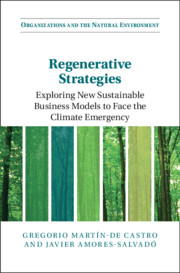Book contents
- Regenerative Strategies
- Organizations and the Natural Environment
- Regenerative Strategies
- Copyright page
- Contents
- Figures
- Tables
- Foreword: Reversing Course
- Acknowledgements
- 1 Introduction
- 2 Assessing the Response to the Climate Grand Challenge
- 3 Business as Usual
- 4 Sustainable Business Models
- 5 Climate Emergency in the Anthropocentric Era
- 6 The Regenerative Strategy
- 7 The Regenerative Strategy
- 8 Concluding Remarks
- Index
- References
2 - Assessing the Response to the Climate Grand Challenge
Institutions, Governments, Business Practice and Management Research
Published online by Cambridge University Press: 28 March 2024
- Regenerative Strategies
- Organizations and the Natural Environment
- Regenerative Strategies
- Copyright page
- Contents
- Figures
- Tables
- Foreword: Reversing Course
- Acknowledgements
- 1 Introduction
- 2 Assessing the Response to the Climate Grand Challenge
- 3 Business as Usual
- 4 Sustainable Business Models
- 5 Climate Emergency in the Anthropocentric Era
- 6 The Regenerative Strategy
- 7 The Regenerative Strategy
- 8 Concluding Remarks
- Index
- References
Summary
The second chapter analyses the response to the climate grand challenge by institutions, governments, business practice and academia. Since the 1980s, climate science has alerted us, with data and evidence, to the serious effects that human intervention is having on the climate. This grand challenge constitutes a global problem that can be plausibly addressed through coordinated and collaborative efforts at a planetary scale, requiring the involvement of governments, supranational institutions, companies and, of course, management academics. From a historical perspective, we introduce the reader to how climate change was initially treated by multinational institutions and governments, and then we delve into the reaction of industry to this evidence, paying special attention to the fossil fuel industry because of its prominent role in the generation of greenhouse gases. Finally, we analyse the role of academia in addressing this challenge, in particular the role of organisations and the natural environment academics.
Keywords
- Type
- Chapter
- Information
- Regenerative StrategiesExploring New Sustainable Business Models to Face the Climate Emergency, pp. 10 - 42Publisher: Cambridge University PressPrint publication year: 2024



